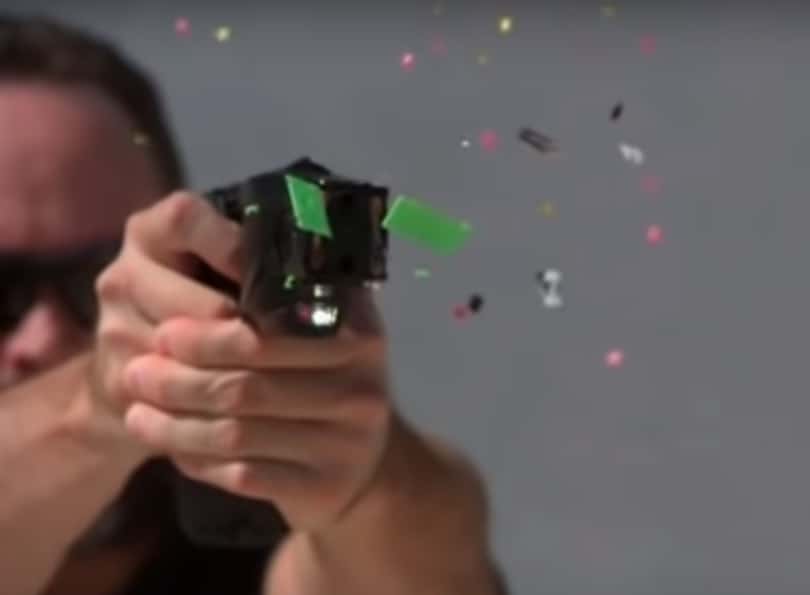
A Taser is an Electrical Control Device. These devices are used to deliver a sub-lethal electric shock to a human target in self defense situations.
In case you didn’t know, to actually produce the shock, the current needs to travel from one electrode, through the body of the attacker, into the other electrode. In a stun gun, this happens when you press the two electrodes up against the attacker.
In a Taser, the electrodes are attached to copper wires that shoot out from the device over a distance of up to 15 feet. The electrodes are in the form of sharp, barbed probes that pierce and attach to the clothing and skin of the target with the same end result as pressing the electrodes of a stun gun up against their skin.
Because Tasers are legal to carry in most states, require little or no background checks and permits and are such an effective means of subduing an attacker, they have become popular self defense items.
In this article, we go over some of the basics about how Tasers can be used safely and what their effects are.
Is A Taser A Good Self Defense Weapon?
Tasers are one of the most suitable weapons available for self defense.
Unlike traditional stun guns, Tasers can be fired from a distance of up to 15 feet, and work on neuro-muscular incapacitation (NMI): they disrupt the nervous system causing involuntary muscular spasms whereas stun guns rely on pain to control an attacker.
Muscular spasms last for as long as the discharge cycle, which depending on the model can be anything between 5 and 30 seconds. This gives you time to discard the device and flee while your attacker is still immobilized. Tasers come with a replacement offer in the event that you have to leave yours at the scene of an attack in order to flee.
A major disadvantage of Tasers, aside from their high price, is that in order to produce a current (which is what conducts the electric shock through the target), both electrodes need to stay in contact. This means that if one electrode misses the target or is dislodged the target will not receive a shock.
In the event that this happens or that you miss your first shot, most models come with a back-up stun gun function. Some high-range models come with two shots.
Are Tasers Legal For Self Defense
Although Tasers are not considered firearms and are legal in the majority of states, there are some states and cities where they are illegal for personal use, and others where their use is subject to restrictions. As laws are reviewed and updated, the localities where Taser use is restricted change, so it’s always best to check the latest information with local authorities before purchasing a weapon.
What Happens When You Taser Someone?
A well-placed Taser shot in an ideal subject will result in severe muscle contractions and spasms, causing them to lose control over their movements for as long as the Taser is discharged.
But the Taser is not infallible. One LAPD report on the weapon found that Taser use resulted in the submission of the suspect just over 50% of the time.
If you’re not too squeamish, check out this video below of a volunteer getting Tasered in slow motion to get an idea of how it should work.
If the probes are too close together (as can happen when the Taser is shot from close up), the affected muscles will be restricted to a smaller set, so the target may still have control over some or most of their body.
People with a history of mental health or drug problems have been known to show a higher tolerance to being Tasered, and it should be noted that body fat and baggy clothing reduce the strength of the shock.
A well-placed Taser shot will knock most ordinary people off their feet. The problem lies in landing a well-placed shot and hoping that your attacker’s reaction to being Tasered is not extraordinary.
What Effects Does A Taser Have On The Body?
Basically, Tasers electrocute their target. An electric current runs from the power unit, down the copper cable, through the probe and the target’s skin into their body and then back out the other probe.
As shocks go it’s apparently on par with touching an electric fence repeatedly.
Because our nervous system uses very weak electrical impulses to communicate with our bodies, this sudden, massive jolt of electricity disrupts normal nerve functioning, causing muscles to contract or spasm.
The physical effects of being Tasered last for as long as the device continues to discharge. Once the current is turned off the muscle spasms stop, and it seems they don’t have any lasting effects on the muscles.
There have, however, been injuries associated with the muscle spasms. Taser manufacturer Axon acknowledges that being shocked by a Taser may result in bone fractures, hernias, ruptures and dislocations, presumably the result of fall-related injuries and extreme muscle contractions.
Aside from the shock itself, the probes used to attach the electrodes to the target’s skin or clothing are about half an inch long with a barbed tip. They can inflict surface wounds and skin burns, and if shot in sensitive areas like the eye or the genitals could cause serious long-term damage.
Can A Person Die From Being Tasered?
The short answer is Yes. Research and history show that a taser is capable of killing a person based on where the target is hit and the physiology of the victim. Let’s take a further look at this…
Although Axon, the manufacturer of Taser, has a long history of taking medical examiners to court if they cite a Taser as a cause of death, the fact that they’ve changed the description of the weapon from “non-lethal” to “less-lethal” makes it fairly clear that it is capable of killing a person.
The 2-4 milliAmp charge delivered by a Taser should not, theoretically, cause more than muscle contractions in a healthy person. Despite this, according to Reuters.com, there have been over 1000 cases where a subject that had been Tasered died shortly afterward. If you’d like to read this article, you can find it here
In most cases, the primary cause of death was listed as cardiac arrest. Often this was related to a history of drug use by the victim and prolonged or repeated discharges, but Axon has started advising that shooting at the chest area poses a greater risk of cardiac arrest.
Axon also advises that children, the aged and pregnant women are more at risk of complications from being Tasered.
Can Tasers Cause Nerve Damage Or Seizures?
Because Tasers tend to be used in high-risk conflictive situations, there hasn’t been much opportunity to carry out controlled studies of their effects on human physiology.
One recent study undertaken by onlinelibrary.wiley.com made use of healthy volunteers to test the effects of Tasers in a controlled environment. Their results suggested that being shocked by a Taser caused subjects to fare worse in cognitive tests but that the effects wore off after an hour.
There have been cases where subjects have suffered seizures directly after being Tasered. There is more risk of this happening if one of the Taser probes attaches directly to the head.
No permanent nerve damage as a direct result of Taser use has been reported.
Do Tasers Work On Bears? Will It Stop A Bears?
There are reports of Tasers having been used successfully to deter aggressive bears. The animals were reportedly immobilized for as long as the shock continued. Upon regaining control of their muscles they moved off rather than reacting aggressively.
There are suggestions that the probes might not be sturdy enough to penetrate the thick fur and skin of wild animals, or that the shock would not be strong enough to subdue them. An additional worry is that once the shock stops the bear might be even angrier and still within 15 feet of you.
Research into the use of Tasers to condition and control problematic bears and other wildlife prompted Axon to launch a $2000 Wildlife Electronic Control Device at one stage, featuring longer reach and stronger currents. The model received a lot of criticism from wildlife enthusiasts and animal rights activists and appears to have been discontinued.
How Much Does A Taser Cost?
A Taser will cost you anywhere from $300 to over $1000, depending on the model you choose.
- The Taser Pulse costs around $300 – $400. It is the go-to Taser model, resembling a small handgun and emitting 30-second electrical pulses.
- The Taser C2 Bolt is a compact model, designed for ease of carrying. It costs around $300 – $400.
- The Taser M26C is designed to resemble a gun. It sends out a 5-second pulse each time the trigger is pulled. The M26C costs around $400 – $500.
- The Taser X2 is lightweight and compact like the C2 Bolt, but easy to aim and grip like the M26C. You can choose between 10-second, 20-second and 30-second pulses and it can fire two cartridges with no need to reload in between. It costs from around $1000.
Safety Tips When Using A Taser
Although a Taser is less lethal than a gun or knife it is nonetheless a dangerous weapon and should be handled with due care. We compiled a few safety tips for new users below.
- Learn to use your Taser properly. Most packages come with a couple of practice rounds. Follow the user manual and familiarise yourself with your weapon.
- Test that your Taser is working before you take it out with you. Removing the cartridge and pulling the trigger should release a spark at the firing end.
- Fire the Taser from an appropriate distance. Although Tasers can fire up to 15 feet the further you are away from your target the less likely it is that both probes will make good contact. Experts recommend a distance of 7 feet.
- Use the laser site to aim the Taser at the most effective areas of the body – between the hips and the neck.
- The electrical discharge from a Taser can ignite flammable materials. Be careful not to aim it in the direction of any explosives or accelerants.
Although Tasers have their drawbacks, not least of all the price, they are a worthwhile investment in personal safety. Users should be aware and keep in mind that they are handling a potentially lethal weapon, and use it accordingly.

